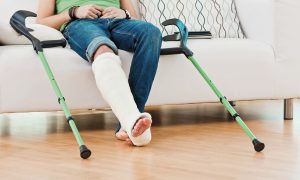Meditation Alters the Brains of Patients with Residual Symptoms after Accidental Physical Injury
By John M. de Castro, Ph.D.
“Mindfulness meditation can help you recover from injury by changing your perception of the circumstance/trauma/event. . . . You can come to know if pain is authentic or based on fear. You can take an honest look at how much you are building up the meaning of an injury and causing yourself more pain. You can direct your mind towards what is important, rather than being distracted by irrational worries and beliefs that are based in fiction or illusion.” – Jennifer Houghton
Accidental or unintentional injuries occur due to external forces. In the United States there are nearly 40 million visits to doctors’ offices and 30 million emergency room visits for accidental injuries. The most frequent causes are automobile accidents and falls. Often patients have physical and mental distress that continues even with medical treatment for a year or more. These are termed post-traumatic residual disabilities. They are obviously a major problem for the ability of the patients to conduct their lives.
Meditation training has been found to be an effective treatment for a myriad of physical and mental problems resulting from accident, disease, or post-traumatic stress. It has also been established that meditation practice alters brain structure and electrical activity. So, it would make sense to employ meditation training for patients with post-traumatic residual disabilities and examine brain activity after the training.
In today’s Research News article “Short-term meditation modulates EEG activity in subjects with post-traumatic residual disabilities.” (See summary below or view the full text of the study at: https://www.ncbi.nlm.nih.gov/pmc/articles/PMC6402287/), Hata and colleagues recruited adult patients with physical and mental distress that continued even with medical treatment for a year or more and a group of healthy normal control participants. The participants with post-traumatic residual disabilities were provided audio recording led meditation practice and asked to meditate for 24 minutes daily for 8 weeks. Before and after practice they were measured for distress from disability and mindfulness and were subjected to an Electroencephalographic (EEG) technique called Low Resolution Electromagnetic Tomography (eLORETA) while at rest and while meditating. Recordings were only performed once for the normal control participants who did not meditate.
The meditation practice produced a significant increase in mindfulness in the patients. In comparison to the normal controls, meditation produced increased current densities in the inferior parietal module of the participants with post-traumatic residual disabilities. They also found that changes in the brain current densities in the precuneus were positively associated with work or daily difficulties resulting from the injury.
This study demonstrated that meditation practice produces changes in the electrical characteristic in the brains of patients with post-traumatic residual disabilities. Importantly, the greater the increase in precuneus current density the greater the improvement in daily physical difficulties resulting from the injuries. So, meditation practice may be useful for the relief of these difficulties. But the effects were not large and there wasn’t a comparable control condition. So, these results must be seen as tentative until a larger randomized controlled trial can be implemented.
So, meditation alters the brains of patients with residual symptoms after accidental physical injury.
“meditation is about establishing a different relationship with your thoughts and affirming your body’s ability to heal itself. You’re training yourself to place your attention where and when you want. This is very powerful. It gives you the ability to direct your thoughts (and mood) in more productive and peaceful directions. This ability has profound self-healing implications for physical and mental health.” – Caroline Jordan
CMCS – Center for Mindfulness and Contemplative Studies
This and other Contemplative Studies posts are also available on Google+ https://plus.google.com/106784388191201299496/posts and on Twitter @MindfulResearch
Study Summary
Hata, M., Hayashi, N., Ishii, R., Canuet, L., Pascual-Marqui, R. D., Aoki, Y., … Ito, T. (2019). Short-term meditation modulates EEG activity in subjects with post-traumatic residual disabilities. Clinical neurophysiology practice, 4, 30–36. doi:10.1016/j.cnp.2019.01.003
Abstract
Objective
Neurophysiological changes related to meditation have recently attracted scientific attention. We aimed to detect changes in electroencephalography (EEG) parameters induced by a meditative intervention in subjects with post-traumatic residual disability (PTRD), which has been confirmed for effectiveness and safety in a previous study. This will allow us to estimate the objective effect of this intervention at the neurophysiological level.
Methods
Ten subjects with PTRD were recruited and underwent psychological assessment and EEG recordings before and after the meditative intervention. Furthermore, 10 additional subjects were recruited as normal controls. Source current density as an EEG parameter was estimated by exact Low Resolution Electromagnetic Tomography (eLORETA). Comparisons of source current density in PTRD subjects after the meditative intervention with normal controls were investigated. Additionally, we compared source current density in PTRD subjects between before and after meditative intervention. Correlations between psychological assessments and source current density were also explored.
Results
After meditative intervention, PTRD subjects exhibited increased gamma activity in the left inferior parietal lobule relative to normal controls. In addition, changes of delta activity in the right precuneus correlated with changes in the psychological score on role physical item, one of the quality of life scales reflecting the work or daily difficulty due to physical problems.
Conclusions
These results show that the meditative intervention used in this study produces neurophysiological changes, in particular the modulation of oscillatory activity of the brain.
Significance
Our meditative interventions might induce the neurophysiological changes associated with the improvement of psychological symptoms in the PTRD subjects.
https://www.ncbi.nlm.nih.gov/pmc/articles/PMC6402287/
